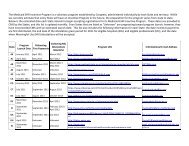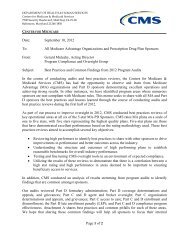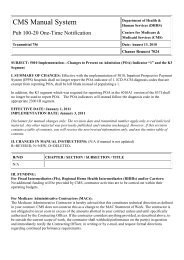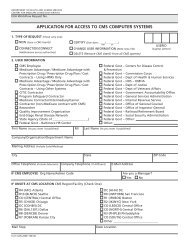CMS Manual System - Centers for Medicare & Medicaid Services
CMS Manual System - Centers for Medicare & Medicaid Services
CMS Manual System - Centers for Medicare & Medicaid Services
You also want an ePaper? Increase the reach of your titles
YUMPU automatically turns print PDFs into web optimized ePapers that Google loves.
<strong>CMS</strong> <strong>Manual</strong> <strong>System</strong><br />
Pub. 100-04 <strong>Medicare</strong> Claims Processing<br />
Department of Health &<br />
Human <strong>Services</strong> (DHHS)<br />
<strong>Centers</strong> <strong>for</strong> <strong>Medicare</strong> &<br />
<strong>Medicaid</strong> <strong>Services</strong> (<strong>CMS</strong>)<br />
Transmittal 118 Date: MARCH 5, 2004<br />
CHANGE REQUESTS 2984<br />
THE ATTACHED CR REPLACES THE CONFIDENTIAL REQUIREMENT,<br />
FILE NAME R19_OTN COMMUNICATED ON NOVEMBER 7, 2003.<br />
I. SUMMARY OF CHANGES: We are making changes to reflect billing policy <strong>for</strong><br />
Darbepoetin Alfa (Aranesp) and Epoetin Alfa (EPO).<br />
NEW/REVISED MATERIAL - EFFECTIVE DATE: April 1, 2004<br />
*IMPLEMENTATION DATE: April 5, 2004<br />
Disclaimer <strong>for</strong> manual changes only: The revision date and transmittal number apply<br />
to the red italicized material only. Any other material was previously published and<br />
remains unchanged. However, if this revision contains a table of contents, you will<br />
receive the new/revised in<strong>for</strong>mation only, and not the entire table of contents.<br />
II. CHANGES IN MANUAL INSTRUCTIONS:<br />
(R = REVISED, N = NEW, D = DELETED –<br />
R/N/D CHAPTER/SECTION/SUBSECTION/TITLE<br />
R 8/Table of Contents<br />
R 8/60/60.4 Epoetin Alfa (EPO)<br />
R 8/60/60.4.1/Epoetin Alfa (EPO) Facility Billing Requirements Using UB-<br />
92/Form <strong>CMS</strong>-1450<br />
R 8/60/60.4.2/Epoetin Alfa (EPO) Supplier Billing Requirements (Method II) on<br />
the Form <strong>CMS</strong>-1500<br />
R 8/60/60.4.2.1/Other In<strong>for</strong>mation Required on the Form <strong>CMS</strong>-1500 <strong>for</strong> Epoetin<br />
Alfa (EPO)<br />
R 8/60/60.4.2.2/Completion of Subsequent Form <strong>CMS</strong>-1500 Claims <strong>for</strong> Epoetin<br />
Alfa (EPO)<br />
R 8/60/60.4.3/ Payment Amount <strong>for</strong> Epoetin Alfa (EPO)<br />
R 8/60/60.4.3.1/ Payment <strong>for</strong> Epoetin Alfa (EPO) in Other Settings<br />
R 8/60/60.4.3.2/ Epoetin Alfa (EPO) Provided in the Hospital Outpatient<br />
Departments<br />
R 8/60/60/60.4.4/ Epoetin Alfa (EPO) Furnished to Home Patients<br />
N 8/60/60.7/ Darbepoetin Alfa (Aranesp) <strong>for</strong> ESRD Patients<br />
N 8/60/60.7.1/ Darbepoetin Alfa (Aranesp) Facility Billing Requirements Using<br />
UB-92/Form <strong>CMS</strong>-1450<br />
N 8/60/60.7.2/ Darbepoetin Alfa (Aranesp) Supplier Billing Requirements<br />
(Method II) on the Form <strong>CMS</strong>-1500 and Electronic Equivalent<br />
N 8/60/60.7.2.1/ Other In<strong>for</strong>mation Required on the Form <strong>CMS</strong>-1500 <strong>for</strong>
Darbepoetin Alfa (Aranesp)<br />
N 8/60/60.7.2.2/ Completion of Subsequent Form <strong>CMS</strong>-1500 Claims <strong>for</strong><br />
Darbepoetin Alfa (Aranesp)<br />
N 8/60/60.7.3/ Payment Amount <strong>for</strong> Darbepoetin Alfa (Aranesp)<br />
N 8/60/60.7.3.1/ Payment <strong>for</strong> Darbepoetin Alfa (Aranesp) in Other Settings<br />
N 8/60/60.7.3.2/ Payment <strong>for</strong> Darbepoetin Alfa (Aranesp) in the Hospital<br />
Outpatient Department<br />
N 8/60/60.7.4/ Darbepoetin Alfa (Aranesp) Furnished to Home Patients<br />
R 8/60/90.5.1/ Billable UB-92 Revenue Codes Under Method II<br />
*III. FUNDING:<br />
These instructions shall be implemented within your current operating budget.<br />
IV. ATTACHMENTS:<br />
X Business Requirements<br />
X <strong>Manual</strong> Instruction<br />
Confidential Requirements<br />
One-Time Notification<br />
Recurring Update Notification<br />
*<strong>Medicare</strong> contractors only
Attachment – Business Requirements<br />
Pub. 100-04 Transmittal: 118 Date: March 5, 2004 Change Request: 2984<br />
THE ATTACHED CR REPLACES THE CONFIDENTIAL REQUIREMENT, FILE<br />
NAME R19_OTN COMMUNICATED ON NOVEMBER 7, 2003. PLEASE<br />
DISCARD CR 2984 DATED NOVEMBER 7, 2003.<br />
SUBJECT: Frequency Limitations <strong>for</strong> Darbepoetin Alfa (trade name Aranesp) For<br />
Treatment Of Anemia In End Stage Renal Disease (ESRD) Patients On<br />
Dialysis.<br />
I. GENERAL INFORMATION<br />
This notification contains instructions <strong>for</strong> frequency limitations <strong>for</strong> Darbepoetin alfa<br />
(Aranesp) <strong>for</strong> End Stage Renal Disease patients on dialysis received on or after April 1,<br />
2004. The frequency limitations <strong>for</strong> Epoetin Alfa (trade name EPO) will remain the<br />
same. Aranesp should continue to be paid in accordance with the payment guidelines in<br />
CR2963, (One Time Notification – Change in Coding on <strong>Medicare</strong> Claims <strong>for</strong><br />
Darbepoetin Alfa (trade name Aranesp) and Epoetin Alfa (trade name Epogen, EPO) <strong>for</strong><br />
Treatment of Anemia in End Stage Renal Disease (ESRD) Patients on Dialysis—<br />
Transmittal 39, Dated January 6, 2004) and EPO will continue to be paid at $10 per 1000<br />
units.<br />
Darbepoetin Alfa is given once a week according to its Food and Drug Administrationapproved<br />
labeling. For this reason, we will allow it to be billed a maximum of 5 times<br />
during any calendar month. Coverage rules <strong>for</strong> darbepoetin alfa are the same as epoetin<br />
alfa <strong>for</strong> ESRD-related anemia.<br />
This notification does not apply to payment of Aranesp and EPO <strong>for</strong> physicians.<br />
Physicians will continue to receive the payment established in the MMA Drug Payment<br />
Limits Pricing File.<br />
A. Background:<br />
Darbepoetin Alfa (Aranesp)<br />
Section 1881(b)(11)(B) of the Social Security Act provides <strong>for</strong> payment of erythropoetin<br />
when provided to a patient determined to have ESRD. Darbepoetin alfa, a new<br />
erythropoetin like product, differs from epoetin alfa by the addition of two carbohydrate<br />
chains, which lengthen the biologic half-life. This change affects how often the biological<br />
can be administered, and results in a decreased dosing schedule <strong>for</strong> darbepoetin alfa by<br />
comparison to epoetin alfa.<br />
Amgen has received Food and Drug Administration approval to market darbepoetin alfa<br />
as Aranesp <strong>for</strong> treatment of anemia related to chronic renal failure, including patients<br />
both on and not on dialysis. Because darbepoetin alfa has two additional carbohydrate
side-chains, it is not structurally identical to epoetin alfa. Both products use the same<br />
biological mechanism to produce the same clinical result, stimulation of the bone marrow<br />
to produce red blood cells. However, these biologicals are dosed in different units.<br />
Epoetin alfa is dosed in units per kilograms (U/kg) of patient weight and darbepoetin alfa<br />
as Aranesp in micrograms per kilogram (mcg/kg). The difference in dosing metric is due<br />
to changes in accepted convention at the time of each product’s development.<br />
B. Policy:<br />
<strong>CMS</strong> staff solicited relevant in<strong>for</strong>mation from the industry, engaged in discussions with<br />
experts and industry representatives, and reviewed the available research literature as of<br />
the end of August 2003. For patients on dialysis, the data from the literature and the<br />
in<strong>for</strong>mation submitted confirmed that darbepoetin alfa is as effective as epoetin alfa in<br />
maintaining hematocrit levels in patients with chronic kidney disease.<br />
C. Provider Education:<br />
A provider education article related to this instruction will be available at<br />
www.cms.hhs.gov/medlearn/matters shortly after the CR is released. You will receive<br />
notification of the article release via the established "medlearn matters" listserv.<br />
Intermediaries and carriers (including DMERCs) shall post this article, or a direct link to<br />
this article, on their website and include in<strong>for</strong>mation about it in a listserv message within<br />
one week of the availability of the provider education article. In addition, the<br />
intermediaries and carriers’ (including DMERCs) education article must be included in<br />
their next regularly scheduled bulletin.<br />
II. BUSINESS REQUIREMENTS<br />
“Shall” denotes a mandatory requirement<br />
“Should” denotes an optional requirement<br />
Requirement #<br />
2984.1<br />
Requirements<br />
The contractor shall accept darbepoetin alfa, Q4054, with the<br />
following limitations: 5 times in 30/31 days.<br />
Responsibility<br />
FI, & SSM<br />
2984.2 The contractor shall continue using the Epoetin Alfa, Q4055,<br />
limitations of 13/14 in 30/31 days.<br />
FI, & SSM<br />
2984.3 The shared system must create an edit to reject any unit of<br />
measure qualifier other than UN <strong>for</strong> Aranesp, Q4054, and EPO,<br />
Q4055.<br />
Carrier,<br />
DMERC &<br />
VIPS<br />
III. SUPPORTING INFORMATION & POSSIBLE DESIGN CONSIDERATIONS<br />
A. Other Instructions:<br />
X-Ref Requirement # Instructions<br />
N/A<br />
B. Design Considerations:
X-Ref Requirement # Recommendation <strong>for</strong> <strong>Medicare</strong> <strong>System</strong> Requirements<br />
N/A<br />
C. Interfaces: N/A<br />
D. Contractor Financial Reporting /Workload Impact: N/A<br />
E. Dependencies: N/A<br />
F. Testing Considerations: N/A<br />
SCHEDULE, CONTACTS, AND FUNDING<br />
Effective Date: April 1, 2004<br />
Implementation Date: April 5, 2004<br />
Pre-Implementation Contact(s):<br />
Henry Richter, 410-786-4562 & Lynn Merritt-<br />
Nixon, 410-786-4652 (Policy)<br />
Pat Barrett, 410-786-0508 &<br />
Doris Barham, 410-786-6146 (FI)<br />
Melvia Page-Lasowski, 410-786-4727 (Carrier)<br />
Renee Hildt, 410-786-1446 (DMERC)<br />
Post-Implementation Contact(s):<br />
Regional Office<br />
These instructions should be<br />
implemented within your current<br />
operating budget.
<strong>Medicare</strong> Claims Processing <strong>Manual</strong><br />
Chapter 8 - Outpatient ESRD Hospital, Independent Facility, and<br />
Physician/Supplier Claims<br />
Table of Contents<br />
(Rev 118, 03-05-04)<br />
60.7 – Darbepoetin Alfa (Aranesp) <strong>for</strong> ESRD Patients<br />
60.7.1 – Darbepoetin Alfa (Aranesp) Facility Billing Requirements Using<br />
UB-92/Form <strong>CMS</strong>-1450<br />
60.7.2 – Darbepoetin Alfa (Aranesp) Supplier Billing Requirements (Method II)<br />
on the Form <strong>CMS</strong>-1500 and Electronic Equivalent<br />
60.7.2.1 – Other In<strong>for</strong>mation Required on the Form <strong>CMS</strong>-1500 <strong>for</strong> Darbepoetin<br />
Alfa (Aranesp)<br />
60.7.2.2 – Completion of Subsequent Form <strong>CMS</strong>-1500 Claims <strong>for</strong> Darbepoetin<br />
Alfa (Aranesp)<br />
60.7.3 – Payment Amount <strong>for</strong> Darbepoetin Alfa (Aranesp)<br />
60.7.3.1 – Payment <strong>for</strong> Darbepoetin Alfa (Aranesp) in Other Settings<br />
60.7.3.2 – Payment <strong>for</strong> Darbepoetin Alfa (Aranesp) in the Hospital Outpatient<br />
Department<br />
60.7.4 - Darbepoetin Alfa (Aranesp) Furnished to Home Patients
60.4 - Epoetin Alfa (EPO)<br />
(Rev 118, 03-05-04)<br />
A3-3644.D.1 - D.3, PRM-1-2710.3.A - D, RDF-207.5.A - C, B3-2049.5.B, B3-<br />
2049.3.B.1, PM AB 97-2, PM AB-00-76, PM A-01-106, RDF-319<br />
Coverage rules <strong>for</strong> EPO are explained in the <strong>Medicare</strong> Benefit Policy <strong>Manual</strong>, Chapter<br />
11. For an explanation of Method I and Method II reimbursement <strong>for</strong> patients dialyzing<br />
at home, see §40.1.<br />
Intermediaries pay <strong>for</strong> EPO to ESRD facilities as a separately billable drug to the<br />
composite rate. No additional payment is made to administer EPO, whether in a facility<br />
or a home.<br />
If the beneficiary obtains EPO from a supplier <strong>for</strong> self-administration, the supplier bills<br />
the DMERC and the DMERC pays at the rate shown in §60.4.3<br />
Program payment may not be made to a physician <strong>for</strong> EPO <strong>for</strong> self-administration. Where<br />
EPO is furnished by a physician payable as, “incident to services” the carrier processes<br />
the claim.<br />
EPO Payment Methodology<br />
Type of provider Separately<br />
Billable<br />
In-facility freestanding and<br />
hospital based ESRD facility<br />
Self-administer Home Method I X<br />
X<br />
DMERC<br />
Payment<br />
Self administer Home Method II X<br />
Incident to physician in facility or<br />
<strong>for</strong> self-administration *<br />
No<br />
payment<br />
* <strong>Medicare</strong> pays <strong>for</strong> a drug if self-administered by a dialysis patient when EPO is a renal<br />
facility, the service is not an “incident to” service and not under the “incident to”<br />
provision.<br />
The Dialysis Outcomes Quality Initiative recommends a threshold hematocrit value range<br />
of 33 to 36 percent. National policy requires FIs and carriers to identify practitioners with<br />
an atypical number of patients with hematocrit levels above a 90-day rolling average of<br />
37.5 percent <strong>for</strong> routine medical; review activities, such as provider education or prepayment<br />
reviews. That is, medical documentation is not required <strong>for</strong> a single value over<br />
36 percent. However, FIs and carriers must make a determination upon post payment<br />
review if the treating physician argues it is medically necessary to have a target<br />
hematocrit that is greater than 36 percent (which would then exceed the rolling average of<br />
37.5 percent). These hematocrit requirements apply only to EPO furnished as an ESRD<br />
X
enefit under §1881(b) of the Social Security Act (the Act). EPO furnished incident to a<br />
physician’s service is not included in this policy. Carriers have discretion <strong>for</strong> local policy<br />
<strong>for</strong> EPO furnished as “incident to service.”<br />
60.4.1 - Epoetin Alfa (EPO) Facility Billing Requirements Using UB-<br />
92/Form <strong>CMS</strong>-1450<br />
(Rev 118, 03-05-04)<br />
Revenue codes 0634 and 0635 are used to report EPO. Code 0634 reports the number of<br />
administrations under 10,000 units and 0635 reports the number of administrations of<br />
10,000 or more.<br />
The number of units of EPO administered during the billing period is reported with value<br />
code 68.<br />
The hematocrit reading taken prior to the last administration of EPO during the billing<br />
period must also be reported on the UB-92/Form <strong>CMS</strong>-1450 with value code 49.<br />
The hemoglobin reading taken during the billing period must be reported on the UB-<br />
92/Form <strong>CMS</strong>-1450 with value code 48.<br />
The HCPCS code <strong>for</strong> EPO must be included: Q4055 – Injection, Epoetin alfa, 1,000 units<br />
(<strong>for</strong> ESRD on Dialysis).<br />
Either the hematocrit or the hemoglobin reading is required on the bill. The FI must retain<br />
the hematocrit (HCT) or hemoglobin (hgb) reading in a <strong>for</strong>mat accessible to the claims<br />
process <strong>for</strong> use to average readings <strong>for</strong> a 90-day period on future claims.<br />
The statutory payment allowance <strong>for</strong> EPO ($10 per 1000 units) is the only allowance <strong>for</strong><br />
the drug and its administration when used <strong>for</strong> ESRD patients. Payment <strong>for</strong> medical<br />
supplies needed <strong>for</strong> the administration of EPO, whether in the home or in a facility, is<br />
included in the <strong>Medicare</strong> payment rate <strong>for</strong> EPO.<br />
The maximum number of administrations of EPO <strong>for</strong> a billing cycle is 13 times in 30 days<br />
and 14 times in 31 days.<br />
60.4.2 - Epoetin Alfa (EPO) Supplier Billing Requirements (Method II)<br />
on the Form <strong>CMS</strong>-1500 and Electronic Equivalent<br />
(Rev 118, 03-05-04)<br />
A. Claims with dates of service prior to January 1, 2004:<br />
For claims with dates of service prior to January 1, 2004, the correct EPO code to use is<br />
the one that indicates the patient’s most recent hematocrit (HCT) (rounded to the nearest<br />
whole percent) or hemoglobin (Hgb) (rounded to the nearest g/dl) prior to the date of<br />
service of the EPO. For example, if the patient’s most recent hematocrit was 20.5 percent,<br />
bill Q9921; if it was 28.4 percent, bill Q9928.
To convert actual hemoglobin to corresponding hematocrit <strong>for</strong> Q code reporting, multiply<br />
the Hgb value by 3 and round to the nearest whole number. For example, if Hgb = 8.4,<br />
report as Q9925 (8.4 X 3 = 25.2, rounded down to 25).<br />
One unit of service of EPO is reported <strong>for</strong> each 1000 units dispensed. For example if<br />
20,000 units are dispensed, bill 20 units. If the dose dispensed is not an even multiple of<br />
1,000, rounded down <strong>for</strong> 1 - 499 units (e.g. 20,400 units dispensed = 20 units billed),<br />
round up <strong>for</strong> 500 - 999 units (e.g. 20,500 units dispensed = 21 units billed).<br />
Q9920 Injection of EPO, per 1,000 units, at patient HCT of 20 or less<br />
Q9921 Injection of EPO, per 1,000 units, at patient HCT of 21<br />
Q9922 Injection of EPO, per 1,000 units, at patient HCT of 22<br />
Q9923 Injection of EPO, per 1,000 units, at patient HCT of 23<br />
Q9924 Injection of EPO, per 1,000 units, at patient HCT of 24<br />
Q9925 Injection of EPO, per 1,000 units, at patient HCT of 25<br />
Q9926 Injection of EPO, per 1,000 units, at patient HCT of 26<br />
Q9927 Injection of EPO, per 1,000 units, at patient HCT of 27<br />
Q9928 Injection of EPO, per 1,000 units, at patient HCT of 28<br />
Q9929 Injection of EPO, per 1,000 units, at patient HCT of 29<br />
Q9930 Injection of EPO, per 1,000 units, at patient HCT of 30<br />
Q9931 Injection of EPO, per 1,000 units, at patient HCT of 31<br />
Q9932 Injection of EPO, per 1,000 units, at patient HCT of 32<br />
Q9933 Injection of EPO, per 1,000 units, at patient HCT of 33<br />
Q9934 Injection of EPO, per 1,000 units, at patient HCT of 34<br />
Q9935 Injection of EPO, per 1,000 units, at patient HCT of 35<br />
Q9936 Injection of EPO, per 1,000 units, at patient HCT of 36<br />
Q9937 Injection of EPO, per 1,000 units, at patient HCT of 37<br />
Q9938 Injection of EPO, per 1,000 units, at patient HCT of 38<br />
Q9939 Injection of EPO, per 1,000 units, at patient HCT of 39<br />
Q9940 Injection of EPO, per 1,000 units, at patient HCT of 40 or above.<br />
B. Claims with Dates of Service January 1, 2004 and after<br />
The above codes were replaced effective January 1, 2004 by Q4055. This Q code is <strong>for</strong><br />
the injection of EPO furnished to ESRD Beneficiaries on Dialysis. The new code does not<br />
include the hematocrit. See §60.7.<br />
Q4055 – Injection, Epoetin alfa, 1,000 units (<strong>for</strong> ESRD on Dialysis).
The DMERC shall return to provider (RTP) assigned claims <strong>for</strong> EPO, Q4055, that do<br />
not contain a HCT value. For unassigned claims, the DMERC shall deny claims <strong>for</strong><br />
EPO, Q4055 that do not contain a HCT value.<br />
DMERCs must use the following messages when payment <strong>for</strong> the injection ( Q4055)<br />
does not meet the coverage criteria and is denied:<br />
MSN Message 6.5—English: <strong>Medicare</strong> cannot pay <strong>for</strong> this injection because one or<br />
more requirements <strong>for</strong> coverage were not met<br />
MSN Message 6.5—Spanish: <strong>Medicare</strong> no puede pagar por esta inyeccion porque<br />
uno o mas requisitos para la cubierta no fueron cumplidos. (MSN Message 6.5 in<br />
Spanish).<br />
Adjustment Reason Code B:5 Payment adjusted because coverage/program<br />
guidelines were not met or were exceeded.<br />
The DMERCs shall use the following messages when returning as unprocessable<br />
assigned claims without a HCT value:<br />
ANSI Reason Code 16 – Claim/service lacks in<strong>for</strong>mation, which is needed <strong>for</strong><br />
adjudication.<br />
Additional in<strong>for</strong>mation is supplied using remittance advice remarks codes whenever<br />
appropriate.<br />
Remark Code M58 – Missing/incomplete/invalid claim in<strong>for</strong>mation. Resubmit<br />
claim after corrections.<br />
Deductibles and coinsurance apply.<br />
60.4.2.1 - Other In<strong>for</strong>mation Required on the Form <strong>CMS</strong>-1500 <strong>for</strong><br />
Epoetin Alfa (EPO)<br />
(Rev 118, 03-05-04)<br />
The following in<strong>for</strong>mation is required <strong>for</strong> EPO. Incomplete assigned claims are returned<br />
to providers <strong>for</strong> completion. Incomplete unassigned claims are rejected. The rejection<br />
will be due to a lack of a HCT value. Note that when a claim is submitted on paper Form<br />
<strong>CMS</strong>-1500, these items are submitted on a separate document. It is not necessary to enter<br />
them into the claims processing system. This in<strong>for</strong>mation is used in utilization review.<br />
A. Diagnoses - The diagnoses must be submitted according to ICD-9-CM and correlated<br />
to the procedure. This in<strong>for</strong>mation is in Item 21, of the Form <strong>CMS</strong>-1500.<br />
B. Hematocrit (HCT)/Hemoglobin (Hgb) - There are special HCPCS codes <strong>for</strong> reporting<br />
the injection of EPO <strong>for</strong> claims with dates of service prior to January 1, 2004. These<br />
allow the simultaneous reporting of the patient’s latest HCT or Hgb reading be<strong>for</strong>e<br />
administration of EPO.<br />
The physician and/or staff are instructed to enter a separate line item <strong>for</strong> injections of<br />
EPO at different HCT/Hgb levels. The Q code <strong>for</strong> each line items is entered in Item<br />
24D.
1. Code Q9920 - Injection of EPO, per 1,000 units, at patient HCT of 20 or<br />
less/Hgb of 6.8 or less.<br />
2. Codes Q9921 through Q9939 - Injection of EPO, per 1,000 units, at patient<br />
HCT of 21 to 39/Hgb of 6.9 to 13.1. For HCT levels of 21 or more, up to a<br />
HCT of 39/Hgb of 6.9 to 13.1, a Q code that includes the actual HCT levels is<br />
used. To convert actual Hgb to corresponding HCT values <strong>for</strong> Q code<br />
reporting, multiply the Hgb value by 3 and round to the nearest whole<br />
number. Use the whole number to determine the appropriate Q code.<br />
EXAMPLES: If the patient’s HCT is 25/Hgb is 8.2-8.4, Q9925 must be entered<br />
on the claim. If the patient’s HCT is 39/Hgb is 12.9-13.1, Q9939 is entered.<br />
3. Code Q9940 - Injection of EPO, per 1,000 units at patient HCT of 40 or<br />
above.<br />
A single line item may include multiple doses of EPO administered while the<br />
patient’s HCT level remained the same.<br />
Codes Q9920-Q9940 will no longer be recognized by the system if submitted after<br />
March 31, 2004. If claims <strong>for</strong> dates of service prior to January 1, 2004 are<br />
submitted after March 31, 2004, then code Q4055 must be used.<br />
C. Units Administered - The standard unit of EPO is 1,000. The number of 1,000 units<br />
administered per line item is included on the claim. The physician’s office enters 1 in<br />
the units field <strong>for</strong> each multiple of 1,000 units. For example, if 12,000 units are<br />
administered, 12 is entered. This in<strong>for</strong>mation is shown in Item 24G (Days/Units) on<br />
Form <strong>CMS</strong>-1500.<br />
In some cases, the dosage <strong>for</strong> a single line item does not total an even multiple of<br />
1,000. If this occurs, the physician’s office rounds down supplemental dosages of 0 to<br />
499 units to the prior 1,000 units. Supplemental dosages of 500 to 999 are rounded up<br />
to the next 1,000 units.<br />
EXAMPLES<br />
A patient’s HCT reading on August 6 was 22/Hgb was 7.3. The patient received<br />
5,000 units of EPO on August 7, August 9, and August 11, <strong>for</strong> a total of 15,000 units.<br />
The first line of Item 24 of Form <strong>CMS</strong>-1500 shows:<br />
Dates of Procedure Days or<br />
Service Code Units<br />
8/7 - 8/11 Q9922 15<br />
On September 13, the patient’s HCT reading increased to 27/Hgb increased to 9. The<br />
patient received 5,100 units of EPO on September 13, September 15, and September<br />
17, <strong>for</strong> a total of 15,300 units. Since less than 15,500 units were given, the figure is<br />
rounded down to 15,000. This line on the claim <strong>for</strong>m shows:<br />
Dates of Procedure Days or<br />
Service Code Units<br />
9/13 - 9/17 Q9927 15
On October 16, the HCT level increased to 33/Hgb increased to 11. The patient<br />
received doses of 4,850 units on October 16, October 18, and October 20 <strong>for</strong> a total of<br />
14,550 units. Since more than 14,500 units were administered, the figure is rounded<br />
up to 15,000. Form <strong>CMS</strong>-1500 shows:<br />
Dates of Procedure Days or<br />
Service Code Units<br />
10/16 - 10/20 Q9933 15<br />
NOTE: Creatinine and weight identified below are required on EPO claims as<br />
applicable.<br />
D. Date of the Patient’s most recent HCT or Hgb.<br />
E. Most recent HCT or Hgb level - (prior to initiation of EPO therapy).<br />
F. Date of most recent HCT or Hgb level - (prior to initiation of EPO therapy).<br />
G. Patient’s most recent serum creatinine - (within the last month, prior to initiation of<br />
EPO therapy).<br />
H. Date of most recent serum creatinine - (prior to initiation of EPO therapy).<br />
I. Patient’s weight in kilograms<br />
J. Patient’s starting dose per kilogram - (The usual starting dose is 50-100 units per<br />
kilogram.)<br />
60.4.2.2 - Completion of Subsequent Form <strong>CMS</strong>-1500 Claims <strong>for</strong> Epoetin<br />
Alfa (EPO)<br />
(Rev 118, 03-05-04)<br />
Subsequent claims are completed as initial claims in §60.4.2, except the following fields:<br />
A. Diagnoses.<br />
B. Hematocrit or Hemoglobin – For dates of service prior to January 1, 2004, this is<br />
indicated by the appropriate Q code. For dates of service January 1, 2004, and<br />
after, suppliers must indicate the beneficiary’s hematocrit on the claim. (See<br />
60.4.2.) Claims include an EJ modifier to the Q code. This allows the contractor<br />
to identify subsequent claims, which do not require as much in<strong>for</strong>mation as<br />
initial claims and prevent unnecessary development.<br />
C. Number of Units Administered - Subsequent claims may be submitted<br />
electronically.
60.4.3 - Payment Amount <strong>for</strong> Epoetin Alfa (EPO)<br />
(Rev 118, 03-05-04)<br />
A3-3644<br />
For Method I patients, the FI pays the facility $10 per 1,000 units of EPO administered,<br />
rounded to the nearest 100 units (i.e. $1.00 per 100 units). Where EPO is furnished by a<br />
supplier that is not a facility, the DMERC pays at the same rate.<br />
Prior to January 1, 1994, the Method I payment was $11 per 1,000 units. The statutory<br />
payment allowance <strong>for</strong> EPO is the only allowance <strong>for</strong> the drug and its administration.<br />
Payment <strong>for</strong> medical supplies <strong>for</strong> the administration of EPO, whether in the home or in a<br />
facility, is included in the <strong>Medicare</strong> payment rate <strong>for</strong> EPO.<br />
Physician payment is calculated through the drug payment methodology described in<br />
Chapter 17 of the Claims Processing <strong>Manual</strong>.<br />
The composite rate add-on amount (the current $10 per 1,000 unit rate and the past $11<br />
per 1,000 unit rate) is updated nationally by <strong>CMS</strong>. This add-on does not vary<br />
geographically and is the same <strong>for</strong> hospital-based and independent dialysis facilities.<br />
EXAMPLE: The billing period is 2/1/94 - 2/28/94.<br />
The facility provides the following:<br />
Date Units Date Units<br />
2/1 3000 2/15 2500<br />
2/4 3000 2/18 2500<br />
2/6 3000 2/20 2560<br />
2/8 3000 2/22 2500<br />
2/11 2500 2/25 2000<br />
2/13 2500 2/27 2000<br />
Total 31,060 units<br />
For value code 68, the facility enters 31,060. The 31,100 are used to determine the rate<br />
payable. This is 31,060 rounded to the nearest 100 units. The amount payable is 31.1 x<br />
$10 =$311.00. In their systems, FIs have the option of setting up payment of $1.00 per<br />
100 units.<br />
EXAMPLE: 311 x $1.00 = $311.00<br />
If an ESRD beneficiary requires 10,000 units or more of EPO per administration, special<br />
documentation must accompany the claim. It must consist of a narrative report that<br />
addresses the following:<br />
• Iron deficiency. Most patients need supplemental iron therapy while being treated,<br />
even if they do not start out iron deficient;<br />
• Concomitant conditions such as infection, inflammation, or malignancy. These<br />
conditions must be addressed to assure that EPO has maximum effect;
• Unrecognized blood loss. Patients with kidney disease and anemia may easily<br />
have chronic blood loss (usually gastrointestinal) as a major cause of anemia. In<br />
those circumstances, EPO is limited in effectiveness;<br />
• Concomitant hemolysis, bone morrow dysplasia, or refractory anemia <strong>for</strong> a reason<br />
other than renal disease, e.g., aluminum toxicity;<br />
• Folic acid or vitamin B12 deficiencies;<br />
• Circumstances in which the bone morrow is replaced with other tissue, e.g.,<br />
malignancy or osteitis fibrosa cystica; and<br />
• Patient’s weight, the current dose required, a historical record of the amount that<br />
has been given, and the hematocrit response to date.<br />
60.4.3.1 – Payment <strong>for</strong> Epoetin Alfa (EPO) in Other Settings<br />
(Rev 118, 03-05-04)<br />
A3-3644<br />
In the hospital inpatient setting, payment is included in the DRG.<br />
In a skilled nursing facility (SNF), payment <strong>for</strong> EPO covered under the Part B EPO<br />
benefit is not included in the prospective payment rate <strong>for</strong> the resident’s <strong>Medicare</strong>covered<br />
SNF stay.<br />
In a hospice, payment is included in the hospice per diem rate.<br />
For a service furnished by a physician or incident to a physician’s service, payment is<br />
made to the physician by the carrier in accordance with the rules <strong>for</strong> ‘incident to”<br />
services. When EPO is administered in the renal facility, the service is not an “incident<br />
to” service and not under the “incident to” provision.<br />
60.4.3.2 – Epoetin Alfa (EPO) Provided in the Hospital Outpatient<br />
Departments<br />
(Rev 118, 03-05-04)<br />
PM-A-01-106<br />
For patients with chronic renal failure who are not yet on a regular course of dialysis,<br />
EPO administered in a hospital outpatient department is paid under the Outpatient<br />
Prospective Payment <strong>System</strong> (OPPS).<br />
Hospitals use type of bill 13X and report charges under revenue code 0636 with HCPCS<br />
code Q0136 and without value codes 48, 49, 68 or condition codes 70 through 76.
60.4.4 – Epoetin Alfa (EPO) Furnished to Home Patients<br />
(Rev 118, 03-05-04)<br />
B3-4270.1<br />
<strong>Medicare</strong> covers EPO <strong>for</strong> dialysis patients who use EPO in the home, when requirements<br />
<strong>for</strong> a patient care plan and patient selection as described in the <strong>Medicare</strong> Benefit Policy<br />
<strong>Manual</strong>, Chapter 11, are met.<br />
When EPO is prescribed <strong>for</strong> a home patient, it may be either administered in a facility,<br />
e.g., the one shown on the Form <strong>CMS</strong>-382 (ESRD Beneficiary Method Selection Form)<br />
or furnished by a facility or Method II supplier <strong>for</strong> self-administration to a home patient<br />
determined to be competent to administer this drug. For EPO furnished <strong>for</strong> selfadministration<br />
to Method I and Method II home patients determined to be competent, the<br />
renal facility bills its FI and the Method II supplier bills its DMERC. No additional<br />
payment is made <strong>for</strong> training a prospective self-administering patient or retraining an<br />
existing home patient to self-administer EPO.<br />
Method II patients who self-administer may obtain EPO only from either their Method II<br />
supplier, or a <strong>Medicare</strong> certified ESRD facility.<br />
In this case, the DMERC makes payment at the same rate that applies to facilities.<br />
Program payment may not be made <strong>for</strong> EPO furnished by a physician to a patient <strong>for</strong> selfadministration.<br />
60.7 – Darbepoetin Alfa (Aranesp) <strong>for</strong> ESRD Patients.<br />
(Rev 118, 03-05-04)<br />
Coverage rules Aranesp are explained in the <strong>Medicare</strong> Benefit Policy <strong>Manual</strong>, Chapter<br />
11. For an explanation Method I ad Method II reimbursement <strong>for</strong> patients dialyzing at<br />
home see §40.1.<br />
Intermediaries pay <strong>for</strong> Aranesp to ESRD facilities as a separately billable drug to the<br />
composite rate. No additional payment is made to administer Aranesp, whether in a<br />
facility or a home.<br />
If the beneficiary obtains Aranesp from a supplier <strong>for</strong> self-administration, the supplier<br />
bills the DMERC, and the DMERC pays in accordance with MMA Drug Payment<br />
Limits Pricing File.<br />
Program payment may not be made to a physician <strong>for</strong> self-administration of Aranesp.<br />
When Aranesp is furnished by a physician as “incident to services,” the carrier<br />
processes the claim.<br />
For ESRD patients on maintenance dialysis treated in a physician’s office, code<br />
Q4054, “injection, darbepoetin alfa, 1 mcg (<strong>for</strong> ESRD patients),” should continue to be<br />
used with the hematocrit included on the claim. (For ANSI 837 transactions, the<br />
hematocrit (HCT) value is reported in 2400 MEA03 with a qualifier of R2 in 2400
MEA02.) Claims without this in<strong>for</strong>mation will be denied due to lack of documentation.<br />
Physicians who provide Aranesp <strong>for</strong> ESRD patients on maintenance dialysis must bill<br />
using code Q4054.<br />
Darbepoetin Alfa Payment Methodology<br />
Type of provider Separately<br />
In-facility freestanding and<br />
hospital based ESRD facility<br />
Billable<br />
Self-administer Home Method I X<br />
DMERC<br />
Payment<br />
Self administer Home Method II X<br />
Incident to physician in facility or<br />
<strong>for</strong> self-administration *<br />
X<br />
No<br />
payment<br />
• <strong>Medicare</strong> pays <strong>for</strong> a drug if self-administered by a dialysis patient. When<br />
Aranesp is administered in a dialysis facility, the service is not an “incident to”<br />
service, and not under the “incident to” provision.<br />
The Dialysis Outcomes Quality Initiative recommends a threshold hematocrit value<br />
range of 33 to 36 percent. National policy requires FIs and carriers to identify<br />
practitioners with an atypical number of patients with hematocrit levels above a 90day<br />
rolling average of 37.5 percent <strong>for</strong> routine medical; review activities, such as<br />
provider education or pre-payment reviews. That is, medical documentation is not<br />
required <strong>for</strong> a single value over 36 percent. However, FIs and carriers must make<br />
a determination upon post payment review if the treating physician argues it is<br />
medically necessary to have a target hematocrit that is greater than 36 percent<br />
(which would then exceed the rolling average of 37.5 percent). These hematocrit<br />
requirements apply only to Aranesp furnished as an ESRD benefit under §1881(b)<br />
of the Social Security Act (the Act). Aranesp furnished incident to a physician’s<br />
service is not included in this policy. Carriers have discretion <strong>for</strong> local policy <strong>for</strong><br />
Aranesp furnished as “incident to service.”<br />
60.7.1 – Darbepoetin Alfa (Aranesp) Facility Billing Requirements Using<br />
UB-92/Form <strong>CMS</strong>-1450<br />
(Rev 118, 03-05-04)<br />
HCPCS code Q4054 is placed in FL 44. Revenue code 0636 is used to report <strong>for</strong> ESRD<br />
patients on maintenance dialysis.<br />
The hematocrit reading taken prior to the last administration of Aranesp during the<br />
billing period must also be reported on the UB-92/Form <strong>CMS</strong>-1450 with value code 49.<br />
X
The hematocrit reading is required. The FI must retain the hematocrit (HCT) reading<br />
in a <strong>for</strong>mat accessible to the claims process <strong>for</strong> use to average readings <strong>for</strong> a 90-day<br />
period on future claims.<br />
The payment allowance <strong>for</strong> Aranesp is the only allowance <strong>for</strong> the drug and its<br />
administration when used <strong>for</strong> ESRD patients. The maximum number of<br />
administrations of Aranesp <strong>for</strong> a billing cycle is 5 times in 30/ 31days.<br />
60.7.2 Darbepoetin Alfa (Aranesp) Supplier Billing Requirements<br />
(Method II) on the Form <strong>CMS</strong>-1500 and Electronic Equivalent<br />
(Rev 118, 03-05-04)<br />
ESRD patients on dialysis can use Aranesp <strong>for</strong> the treatment of anemia effective<br />
January 1, 2004, the Q code <strong>for</strong> the injection of Aranesp <strong>for</strong> ESRD beneficiaries on<br />
dialysis, is Q4054.<br />
Q4054 – Injection, Darbepoetin alfa, 1 mcg (<strong>for</strong> ESRD on Dialysis).<br />
Method II suppliers must use Item 19 on the <strong>CMS</strong> 1500 to place the most current HCT<br />
value (Q4054). Identify HCT as “HCT = the true value HCT”. For 837P claims, the<br />
Method II supplier must supply the most current HCT value, when billing <strong>for</strong><br />
darbepoetin alfa Q4054, in the 2400 MEA03 with a qualifier of R2 in 2400 MEA02.<br />
DMERCs must apply coverage rules to Aranesp in the same manner that they apply<br />
them to EPO. DMERCs shall accept claims <strong>for</strong> Aranesp, Q4054, from suppliers that<br />
bill <strong>for</strong> Aranesp furnished to home patients <strong>for</strong> self-administration who have elected<br />
home dialysis and Method II payment.<br />
DMERCs must accept HCPCS code Q4054 <strong>for</strong> Aranesp on the <strong>CMS</strong>-1500 or its<br />
electronic equivalent 837 P <strong>for</strong>mat. The DMERC shall return to provider (RTP)<br />
assigned claims <strong>for</strong> claims <strong>for</strong> Aranesp, Q4054, that do not contain a HCT value. For<br />
unassigned claims, the DMERC shall deny claims <strong>for</strong> Aranesp, Q4054, that do not<br />
contain a HCT value.<br />
Method II suppliers must place number of mcg’s of Aranesp Q4054 administered in<br />
Item Field 24G Units on the <strong>CMS</strong>- 1500 <strong>for</strong>m, or 2400 SV104 of the 837P <strong>for</strong>mat.<br />
Method II suppliers must use Item 19 on the <strong>CMS</strong> 1500 to place the most current<br />
HCT value (Q4054). Identify HCT as “HCT = the true value HCT”. For 837P<br />
claims, the Method II supplier must supply the most current HCT value, when<br />
billing <strong>for</strong> Aranesp Q4054, in the 2400 MEA03 with a qualifier of R2 in 2400<br />
MEA02.<br />
DMERCs must use the following messages when payment <strong>for</strong> the Aranesp injection<br />
(Q4054) does not meet the coverage criteria and is denied:<br />
MSN Message 6.5—English: <strong>Medicare</strong> cannot pay <strong>for</strong> this injection because one or<br />
more requirements <strong>for</strong> coverage were not met
MSN Message 6.5—Spanish: <strong>Medicare</strong> no puede pagar por esta inyeccion porque<br />
uno o mas requisitos para la cubierta no fueron cumplidos. (MSN Message 6.5 in<br />
Spanish).<br />
Adjustment Reason Code B:5 Payment adjusted because coverage/program<br />
guidelines were not met or were exceeded.<br />
The DMERCs shall use the following messages when returning as unprocessable<br />
assigned claims without a HCT value:<br />
ANSI Reason Code 16 – Claim/service lacks in<strong>for</strong>mation, which is needed <strong>for</strong><br />
adjudication.<br />
Additional in<strong>for</strong>mation is supplied using remittance advice remarks codes whenever<br />
appropriate.<br />
Remark Code M58 – Missing/incomplete/invalid claim in<strong>for</strong>mation. Resubmit<br />
claim after corrections.<br />
Deductibles and coinsurance apply. DMERCs must pay <strong>for</strong> Aranesp (Q4054) based on<br />
the payment amount in the MMA Drug Payment Limits Pricing File. The contractor<br />
can obtain the rates from the <strong>CMS</strong> website,<br />
www.cms.hhs.gov/providers/drugs/default.asp.<br />
60.7.2.1- Other In<strong>for</strong>mation Required on the Form <strong>CMS</strong>-1500 <strong>for</strong><br />
Darbepoetin Alfa (Aranesp)<br />
(Rev 118, 03-05-04)<br />
The following in<strong>for</strong>mation is required <strong>for</strong> Aranesp. Incomplete assigned claims are<br />
returned to providers <strong>for</strong> completion. Incomplete unassigned claims are rejected. The<br />
rejection will be due to a lack of a HCT value. Note that when a claim is submitted on<br />
paper Form <strong>CMS</strong>-1500, these items are submitted on a separate document. It is not<br />
necessary to enter them into the claims processing system. This in<strong>for</strong>mation is used in<br />
utilization review.<br />
A. Diagnoses - The diagnoses must be submitted according to ICD-9-CM and correlated<br />
to the procedure. This in<strong>for</strong>mation is in Item 21, of the Form <strong>CMS</strong>-1500.<br />
B. Date of the Patient’s most recent HCT.<br />
C. Most recent HCT (prior to initiation of Aranesp therapy).<br />
D. Date of most recent HCT (prior to initiation of Aranesp therapy).<br />
F. Patient’s most recent serum creatinine - (within the last month, prior to initiation of<br />
Aranesp therapy).
G. Date of most recent serum creatinine - (prior to initiation of Aranesp therapy).<br />
H. Patient’s weight in kilograms<br />
I. Patient’s starting dose per kilogram<br />
60.7.2.2- Completion of Subsequent Form <strong>CMS</strong>-1500 Claims <strong>for</strong><br />
Darbepoetin Alfa (Aranesp)<br />
(Rev 118, 03-05-04)<br />
Subsequent claims are completed as initial claims in §60.7.2, except the following fields:<br />
A. Diagnoses.<br />
B. Hematocrit – For dates of service prior to January 1, 2004, this is indicated by the<br />
appropriate Q code. For dates of service January 1, 2004 and after, suppliers<br />
must indicate the beneficiary’s hematocrit on the claim. (See 60.7.2). Claims<br />
include an EJ modifier to the Q code. This allows the contractor to identify<br />
subsequent claims, which do not require as much in<strong>for</strong>mation as initial claims<br />
and prevent unnecessary development.<br />
C. Number of Units Administered - Subsequent claims may be submitted<br />
electronically.<br />
60.7.3 - Payment Amount <strong>for</strong> Darbepoetin Alfa (Aranesp)<br />
(Rev 118, 03-05-04)<br />
For Method I patients, the FI pays the facility per one mcg of Aranesp administered, in<br />
accordance with the MMA Drug Payment Limits Pricing File rounded up to the next<br />
highest whole mcg. When Aranesp is furnished by a supplier that is not a facility, the<br />
DMERC pays at the same rate. The payment amount <strong>for</strong> Aranesp is the only payment<br />
<strong>for</strong> the drug and its administration.<br />
Physician payment is calculated through the drug payment methodology described in<br />
Chapter 17 of the Claims Processing <strong>Manual</strong>.<br />
The coinsurance and deductible are based on the <strong>Medicare</strong> allowance payable, not on the<br />
provider’s charges. The provider may not charge the beneficiary more than 20 percent of<br />
the <strong>Medicare</strong> Aranesp allowance. This rule applies to independent and hospital based<br />
renal facilities.<br />
60.7.3.1 - Payment <strong>for</strong> Darbepoetin Alfa (Aranesp) in Other Settings<br />
(Rev 118, 03-05-04)
In the hospital inpatient setting, payment <strong>for</strong> Aranesp is included in the DRG.<br />
In a skilled nursing facility (SNF), payment <strong>for</strong> Aranesp covered under the Part B<br />
EPO benefit is not included in the prospective payment rate <strong>for</strong> the resident’s<br />
<strong>Medicare</strong>-covered SNF stay.<br />
In a hospice, payment is included in the hospice per diem rate.<br />
For a service furnished by a physician or incident to a physician’s service, payment is<br />
made to the physician by the carrier in accordance with the rules <strong>for</strong> ‘incident to”<br />
services. When Aranesp is administered in the renal facility, the service is not an<br />
“incident to” service and not under the “incident to” provision.<br />
60.7.3.2 - Payment <strong>for</strong> Darbepoetin Alfa (Aranesp) in the Hospital<br />
Outpatient Department<br />
(Rev 118, 03-05-04)<br />
For patients with chronic renal failure who are not yet on a regular course of dialysis,<br />
Aranesp administered in a hospital outpatient department is paid under the OPPS.<br />
Hospitals use bill type 13X and report charges under revenue code 0636, with HCPCS<br />
code Q0137 and without value codes 48, 49, 68 or condition codes 70-76.<br />
60.7.4 – Darbepoetin Alfa (Aranesp) Furnished to Home Patients<br />
(Rev 118, 03-05-04)<br />
B3-4270.1<br />
<strong>Medicare</strong> covers Aranesp <strong>for</strong> dialysis patients who use Aranesp in the home, when<br />
requirements <strong>for</strong> a patient care plan and patient selection as described in the <strong>Medicare</strong><br />
Benefit Policy <strong>Manual</strong>, Chapter 11, are met.<br />
When Aranesp is prescribed <strong>for</strong> a home patient, it may be either administered in a<br />
facility, e.g., the one shown on the Form <strong>CMS</strong>-382 (ESRD Beneficiary Method Selection<br />
Form) or furnished by a facility or Method II supplier <strong>for</strong> self-administration to a home<br />
patient determined to be competent to administer this drug. For Aranesp furnished <strong>for</strong><br />
self-administration to Method I and Method II home patients determined to be competent,<br />
the renal facility bills its FI and the Method II supplier bills its DMERC. No additional<br />
payment is made <strong>for</strong> training a prospective self-administering patient or retraining an<br />
existing home patient to self-administer Aranesp.<br />
Method II home patients who self-administer may obtain Aranesp only from either their<br />
Method II supplier or a <strong>Medicare</strong>-certified ESRD facility.<br />
In this case, the DMERC makes payment at the same rate that applies to facilities.<br />
Program payment may not be made <strong>for</strong> Aranesp furnished by a physician to a patient <strong>for</strong><br />
self-administration.


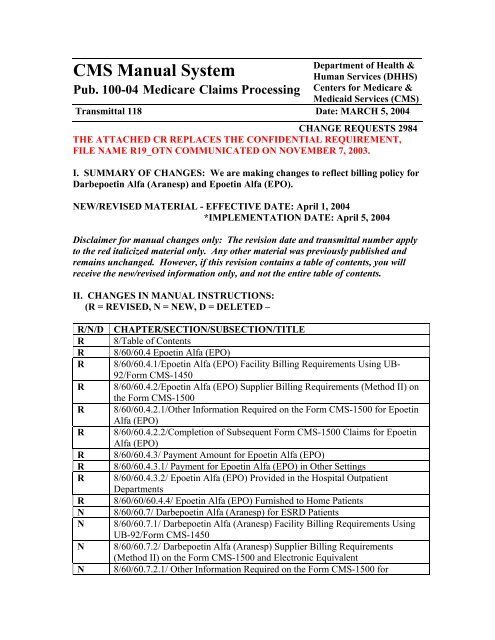
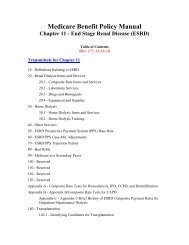
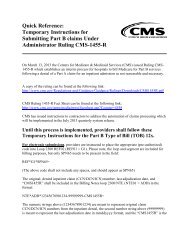

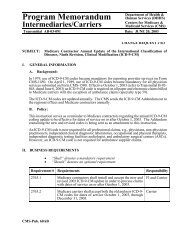

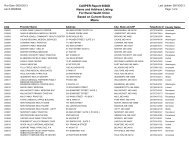
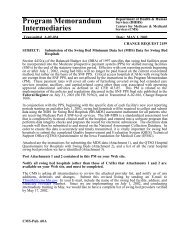
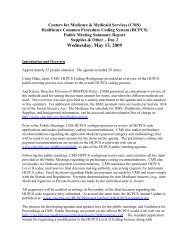

![CMS Change Management Policy [PDF, 106KB] - Centers for ...](https://img.yumpu.com/22011244/1/190x245/cms-change-management-policy-pdf-106kb-centers-for-.jpg?quality=85)
